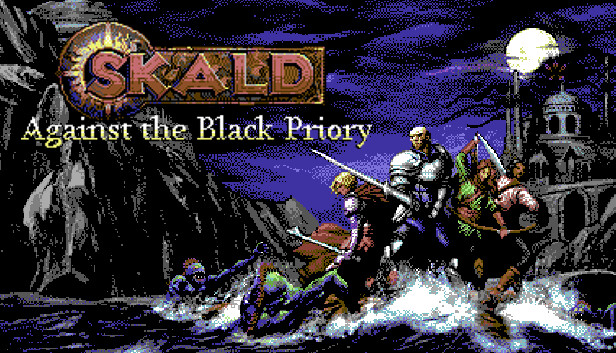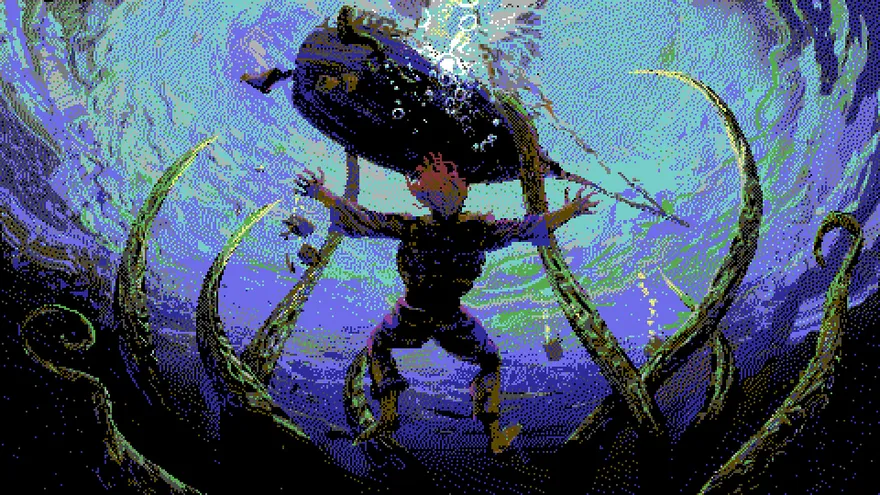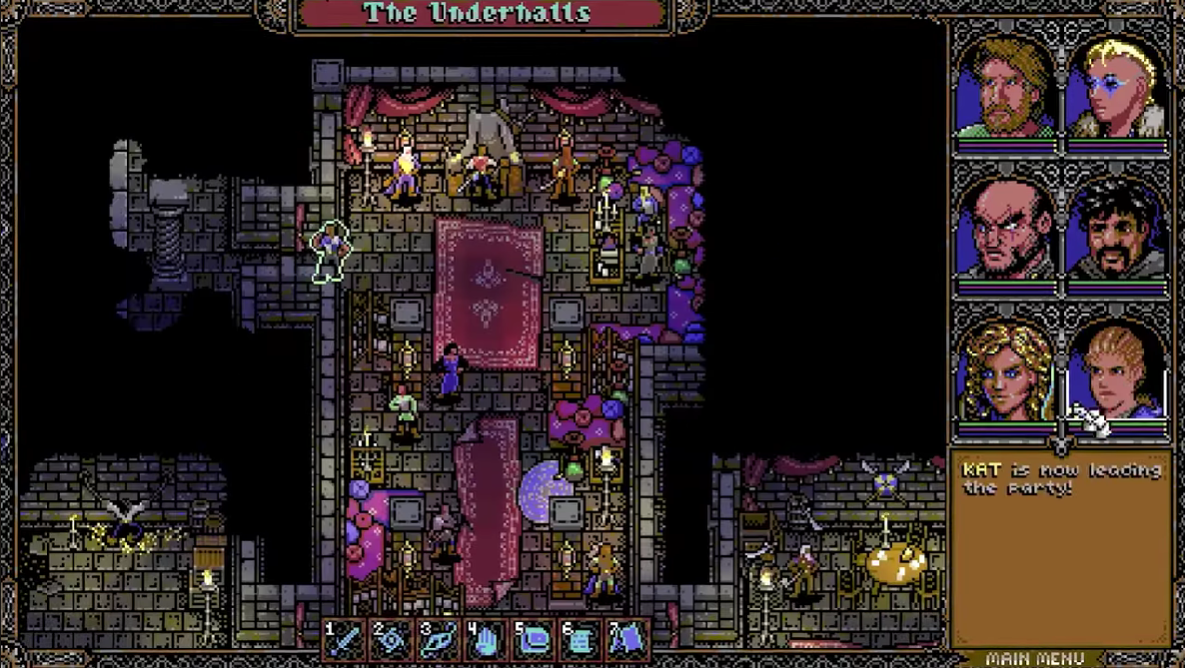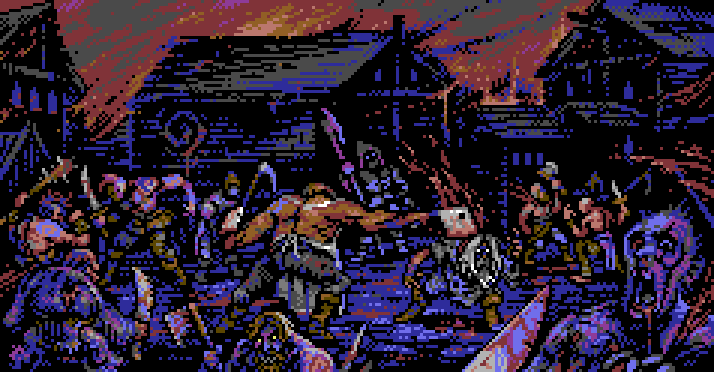Published 5/01/2025
Skald: Against The Black Priory

I understand nostalgia. Nostalgia is potent, the comfort of the past even more so. Even now, I delight in returning to my old childhood favourites, like Super Mario 64 or Jak and Daxter. So, in some respects, I understand people who are always craving what was - but that doesn’t explain why Skald: Against The Black Priory first drew me in. It’s old-school visual design, gorgeous pixel art and classic menuing comes from a time before I was even playing video games, hell, before I was even born. Born from the ashes of games like Ultima, Skald is a love letter to the games that paved the way into turning the PC into a juggernaut of gaming, and can easily draw in those who find themselves nostalgic for what they never experienced. Skald honours the past, and upholds that legacy whilst pushing it further with modern sensibilities.
The Past Reborn
I take so much delight in ‘new’ retro-styled games - seeing the marriage of Nintendo 64/PlayStation era graphics with… well, *improved* game design and direction sends my heart a-flurrying and my wallet a-opening. Last year's solid collect-a-thon Cavern of Dreams felt like the most Banjo-Kazooie since… Well, Banjo-Tooie, and the superb Psuedoregalia feels like it was pulled from the dreamspace of a PlayStation game designer. And so, when I stumbled upon Skald: Against The Black Priory, this felt like the classic, DOS equivalent to those N64/PS1 titles. I expected jank, I expected mediocrity, I expected a cash grab for an era I never really experienced - but I was blown away by this game. It’s not perfect, not nearly, but pretty much all it’s attempts to ‘update’ the DOS style of games, and to deliver a potentially good lovecraftian horror story… Skald won’t be for everyone, but for me, it’s going to be the bar for recreating anything remotely resembling this piece of history.

Whilst many ‘old-school’ game revivals in the same vein as Skald usually put the story on the backburner to give greater focus to whatever they’re paying homage to, but to my surprise, Skald’s storytelling and worldbuilding stands front and center of anything else in the game. Pretty much every notable conversation will feature input and observations from your companions that provide additional information or alternate viewpoints on the horrifying events your party encounters. The game’s premise is simple: You, the son of a noble’s former man-at-arms, are summoned back to your former homestead as a mercenary to search for the lord’s daughter, your old friend, who has vanished in the mysterious Outer Isles. From the jump, the unease begins to grip into you, even in the game’s tutorial/framing sequence, as your character remembers the trauma of their childhood at the hands of a seemingly abusive father.
And it’s that innate, slowly building, dread-inducing horror that made me fall for Skald this hard. Skald’s gorgeous, old-school pixel art results in genuine jumpscares, as the game suddenly pivots from the normal, in-game viewpoint to the horrifyingly beautiful ‘cutscenes’, many of which feel genuinely burned into my mind. Skald almost utterly nails the slow build of horror, with every major event somehow outstripping its last, culminating in a final, enigmatic, and bone-chilling sequence that genuinely ranks amongst my favourites of the year. This game is true horror, true cosmic, lovecraftian horror, and stands alongside titles like Bloodborne or World of Horror as some of the best to come out in the last decade or so - not just in gaming, but in media as a whole. There are moments of joy - villagers rescued, hope restored - but they are all in service of reminding you of the horror that always, always, is lurking at the end of the road.
In Search of Madness
Much of your time in Skald will be spent wandering the various locales of the Outer Isles from a top-down perspective; initially, your scope is limited, as you’re essentially shipwrecked on the isle and are shambling from zone to zone, surviving on what minor aramanets and allies you can find. Gathering as much food as you can, as you cannot rest and heal without filling the bellies of your party; finding the weakest of gear to have something, anything to protect yourself; and helping whatever lost souls you’ll run into, all in the service of that sweet, sweet EXP and gold. But it’s not just wandering! You think you can just trapeze across the Outer Isles, without being repelled by not only its inhabitants, but its very geography?
Whilst you start the game on your own, you’ll eventually stumble upon and unite with enough NPCs to fill out your six-player party, and new companions come at a steady pace that combat the ever growing hordes of eldritch horrors, and no matter what kind of character you built, your six man party will be evenly spread across melee, ranged, and magic proficiency, giving you freedom to really make any character you wish. This goes double for the various skill checks you’ll run across in the overworld and NPC conversations; with the ability to switch characters at any moment, you can utilize any member of your party to pass these - and any additional stat weaknesses can be rounded out by a variety of magic gear. It’s all fairly basic stuff, but it’s functional enough to feel like an additive to Skald as a whole. Honestly, the best skill are the ones that don’t have a physical effect on your party - rather, it’s the ones that reveal more of the Outer Isles doomed, deranged lore that I find oh-so-intoxicating.

Many of the quests and situations you’ll find yourself in - optional or mandatory alike - will have multiple outcomes that, at the end of the day, really feel more like set dressing than actively changing the world around you, but with the game’s emphasis on atmosphere and storytelling, this isn’t really a problem. Nearly every quest, beyond just the rewards, fleshes out the world, a world which feels far bigger then just the game itself. The best quests are the ones you have a greater impact on their outcomes; a handful of major, rather difficult encounters can be totally skipped if you’re quick and keen enough to dance around the situation entirely, and these left me insanely satisfied. Questing ultimately serves to show you the weird, wonderful, and downright spooky Skald wishes to showcase, and there are moments - such as ‘The Play’ or the Witch of the Woods that stick out amongst the game’s best, and are not to be missed. It’s where the game shines in the sense that there is rarely a ‘good’ answer where everyone gets out a live - Skald is about breaking you, slowly but surely, by the journey into the core of madness centered in the Black Priory.
Whilst at first Skald feels like a game that could spread wide, it’s a surprisingly linear game, with a fairly definitive path and sequence of locations to complete. And honestly, I feel this is to its benefit. There’s an excellent sense of ‘illusion of scope’, with its map-based exploration creating the facade of a bigger, more complex world just out of view. But I digress - I really love just wandering the zones of Skald, finding all the little hidden secrets, gear, and quests, many of which are tucked away far more tightly then you’d expect. Far more frequently then I’d expect would I stumble upon a strange NPC here, or the remnants of a massacre (with free loot to boot) over here. It’s the joy of adventure and discovery that was key to these early RPGs, and Skald does great in carrying this ideal. Whilst the linearity does work in the game’s favour, I think the pacing could’ve used some work; more than half the game takes place on the initial island of the Outer Isles, mostly centered around liberating a town from corrupted reavers; post these events, the game rapidly oscillates through engaging enough events until you reach Skald’s dizzying conclusion. The game clocks in at about 10-11 hours, at least on my run, and I think it’s a perfect length - but I think a little more content could’ve been shifted to the midgame to create a generally better paced experience.
Its attempts and puzzles, whilst laudable, never really hit home for me, feeling more akin to padding, and in some cases, such as a handful of situations in the titular Black Priory, I felt the game actively wasn’t giving me the info I needed to progress. On the topic of progression, gear seems to be a bit of an afterthought. It starts interesting enough, with your squad scrambling for whatever weak upgrades they can find to even survive, but halfway through the game, you’re just showered with magic items and thousands of gold pieces, essentially letting spec into any kind of playstyle you’d like, and whilst it helps smooth over more frustrating parts of the game, it certainly takes away from the scavenging feel that feels really engaging in the early game.
What Lurks Below
Combat, whilst not particularly bad, definitely feels like the weakest link in the game. It’s a generally simplistic affair - like general exploration, battles take place from top-down perspective, with characters and enemies' turn order being influenced by their agility stat. Each turn, you can move a few steps, do a basic melee/ranged attack, or use one of the abilities you can invest your upgrade points into. You have to take a few battlefield elements into consideration - namely, making sure you’re not preventing half your melee users from engaging in combat due to single file tunnels, but other than that, most combat situations are the same, sans your opponents - and even they aren’t particularly unique across the game. When it comes to your side of the battlefield, though, combat complexity will vary from class to class - most melee classes, sans the Cleric, are fairly basic, with hard hitting normal attacks and abilities that’ll guarantee a critical or a status effect. Clerics and mages, however, feature wide-ranging kits that can heal, debuff, buff in equal measures with only poor defences as a drawback. Seriously, if you can balance the mana potions needed to sustain them, going all in on your magic users feels almost like a cheat code - though nothing *really* beats the heavy, satisfying sound effect and screen shake of a melee hit, no? I just wish there were more encounters that were more than just… fight a couple of beasts. There are very few that felt like they truly made the most of it’s combat system, and it just contributes to how little I cared about combat sequences in this game as a whole.

The game also notably features a bit of a reverse difficulty curve - enemies feel strong from the get-go, but only really grow in number, not complexity. On the flip side, your party - of which eventually grows to six - are constantly levelling up and finding new gear, especially in the back half of the game, so you eventually reach a moment where you’re steamrolling everything without any real roadblocks. By the end of the game, the only enemies I really struggled with were more magical in nature, slimes and whatnot, who seemingly were resistant to pretty much everything in my arsenal, requiring nothing but time to slaughter. And sadly, combat in this game just becomes a bit of annoyance, rather than a major feature, though the game's 10-15 hour runtime helps prevent this annoyance from ballooning into outright derision. Even with it’s tiled-based combat, it still somehow serves to have loose, imprecise controls - the amount of times I 100% clicked on a certain enemy, right next to one of my characters, but I somehow clicked on the tile *next* to the enemy, causing my character to disengage, ending their turn. Incredibly frustrating, to say the least, but at least on normal difficulty, the game isn’t difficult enough to cost you a battle from such a mistake. It does feel like combat received the least amount of Q&A, but the issues aren’t common enough to ruin anything - just to draw frustration.
In keeping with the dark, haunting tone that pervades the game from moment one, I adore the retro aesthetic-turned HD that Skald employs. Clearly taking inspiration from games like Ultima and its DOS-era kin, the game is simply gorgeous, displaying a mastery in visual design that turns one zone into an anxiety-inducing rout… but can also turn a town or settlement into the last refuge from the end of the world. But even these pale in comparison to the incredible pixel illustrations that pop up for conversations and particularly impactful moments in the story - seriously, some of these illustrations are amongst the most beautiful and dread-inducing I’ve seen in some time. Though, when wandering the overworld and in combat, the heavy pixel art does sometimes lead to issues on readability, pretty much requiring you to perpetually have your finger on the ‘highlight’ key to see what’s interactable and who’s conversable, otherwise you might outright just miss things. Even beyond that, the dense pixelwork can conceal ordinary pathways and doors towards progressions, so an improvement in regards to readability might be important for future titles.
Skald: Against The Black Priory blew me away in many ways, the most important ways for a title like this. A true lovecraftian tale that nails the aesthetics, narrative, and atmosphere that is so key to the subgenre. It’s rare that a game makes me feel so engaged and uncomfortable in equal measure, and keep itself so entrenched in my thoughts for so, so long. But what could’ve genuinely been my game of the year is stymied by afterthought-like combat and certain progression decisions - decisions that don’t kneecap the game, but certainly don’t do much to prop it up. But where it succeeds, it does so brilliantly and terrifyingly, and it left me with enough questions and enough feelings to want whatever Skald’s developer is planning next, now. Skald is an incredible debut, warts and all, and if you have any love for the RPGs of yesteryear, today, this game is required playing, and amongst the game’s of 2024, I believe there is no other game that nailed it’s core concept as well as Skald: Against The Black Priory.
